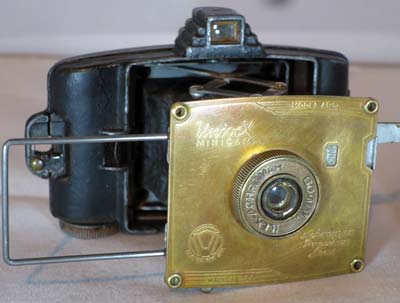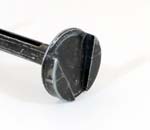Univex AF-5
Specification

| Manufacturer | : | Univex |
|---|---|---|
| Produced | : | 1938 |
| Classification | : | Miniature |
| Body Type | : | Folding Strut |
| Construction | : | Metal |
| Film Type | : | #00 |
| Film Width | : | 1¼ |
| ImageSize | : | 1⅛ x 1½ in |
| No. of Images | : | 6 |
| Lens Type | : | Ilex Achromar |
| Focal Length | : | 60mm |
| Focus Type | : | Fixed |
| Focal Range | : | 0.5m - inf. |
| Aperture Type | : | Fixed |
| Aperture | : | f/16 |
| Shutter Type | : | Leaf |
| Shutter Speeds | : | T, I*(1/100 sec) |
| Size Closed (w x h x d) | : | 87 x 160 x 35 mm |
| Size Open (w x h x d) | : | 87 x 160 x 134 mm |
| Weight | : | 190g |
| * - measured on this camera | ||
Art Deco Credentials
![]()
![]()
![]()
![]()
Significant: Pronounced and self evident
- Produced during the main Art Deco period.
- Cast stepped feature around viewfinder.
- Lined and stepped pattern on front plate.
- Brass front plate
- Metal struts with some chrome rivets.
- Curved body design.
Description
The Universal Camera Corporation of New York City, New York was a successful low-priced camera manufacturer during the 1930s and 40s. The Univex AF series of miniature folding cameras were introduced in 1935. By 1937, over a million Model AF folders had been sold. This camera is the AF-5 model and was the last in the series. It is distinguished by large knurled brass front lens bezel and the stepped feature surrounding the viewfinder.
This camera is designed for either vertical or horizontal format pictures using either the vertical wire frame finder or the horizontal optical viewfinder.

This is so small, it fits easily in the palm of the hand. The body is made of cast metal, the struts are aluminum and the front plate is brass. The bellows are made of paper. The AF-5 has a simple, fixed aperture lens. The shutter has settings for instantaneous, marked as 'SNAP', and time exposure, marked as 'TIME'. There is a tab below the lens plate to change the shutter setting. A wire frame viewfinder can be pulled out of the lens board and is used in conjunction with a rectangular hole cast into the top of the body. A red window is used to count exposures. There is no tripod mount.
This camera requires Univex #00 film which is wound on spools with a special 'V' shaped key for turning.
How to Use
Find the manual here:- Univex AF-5 manual
The camera takes Univex No.00 film which is only available as expired film. Expired film normally needs to be overexposed by 1 stop/decade for colour film or 1 stop per 2 decades for B&W. As there is no way to adjust the exposure, it is unlikely to be successful.
35mm film is too wide for the spools.
You can cut down 120 film but you will probably have to develop the film yourself.
Looks like this is a 'shelf sitter' for me I'm afraid.